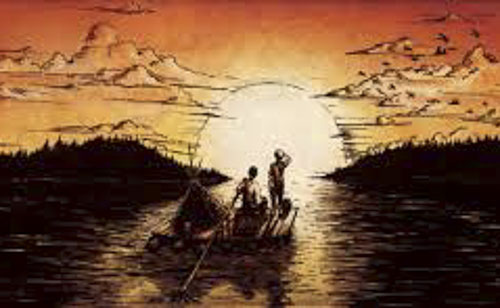
.
For Doug Glover
When Doug wrote to me this morning, to announce that he had “decided to cease publication” of Numéro Cinq, and “find a new life,” he added two points. The first was funny, if self-effacingly untrue: “Maybe I’ll try to become a writer.” As we all know, that attempt has long since been an actual and impressive achievement. The second remark was both truthful and encouraging: “I’m not gloomy or regretful.” Considering what he has accomplished over the past half-dozen years—making available a trove of fiction, poetry, art, and critical commentary, and bringing together a community of writers and artists in this warm place on the web—neither Doug nor the rest of us have reason to be gloomy or regretful. Quite the opposite.
I believe that the cliché that “All good things must come to an end,” has its origin in Chaucer’s great 14th-century narrative poem, Troilus and Criseyde. As it happens, that five-book masterpiece is Chaucer’s only complete long poem, and, for all its tragic love-story, it does not end with either its author or the poem’s hero “gloomy or regretful.” In the finale, at last aware of everything, Troilus ascends to the eighth of the heavenly spheres, from which celestial vantage point he looks down upon the world and “laughs” at all that “cannot last.” But Troilus’s laughter is not merely disdainful; from his observation point in eternity, he sees all in amused perspective, and knows that in his mortal ending there is a new beginning.
Numéro Cinq will survive in its own, secular, version of eternity. As Doug said at the end of his announcement, “All the pieces we’ve published will stay up on the internet.” No new issues will be added, but “the site won’t disappear.” The magazine’s temporal ending coincides with a never-ending beginning, its internet afterlife. By way of valediction, I would like to dedicate to Doug, in admiration, affection, and gratitude, this new essay on beginnings and endings. In truncated form, it was presented, on August 4, as a talk at the eighth Mark Twain Quadrennial Conference in Elmira, where Huckleberry Finn was completed in 1885, precisely five centuries after Chaucer published Troilus and Criseyde.
Pat Keane July 12, 2017
.
***
.
The beginnings and endings of all human endeavors are untidy…the writing of a novel…and, eminently, the finish of a voyage.
John Galsworthy, Over the River (1933), 9th & final novel in The Forsyte Saga
.
1.
In The Pound Era, Hugh Kenner introduces T. S. Eliot in what may seem an odd way: “Elegant, shy from great sensitivities and great gifts, the youngest of eight children, he came, by way of several Academies, from a birthplace by Twain’s Mississippi in Twain’s lifetime.” As Kenner goes on to note, Eliot’s was “a family of some local prominence, connected, moreover, with the Massachusetts Eliots.” Of course his family also had deep and distinguished roots in England, in East Coker, in Somerset, and, when young Eliot left Boston and Harvard for the continent and then London in 1914, he rapidly became, in manner, dress, and speech, more English than English, certainly more English than American. Just as Sam Clemons of Missouri had reinvented himself as “Mark Twain,” the world-traveler decked out in that iconic white suit, so Tom Eliot of Missouri, the American who, along with Henry James, most thoroughly reinvented himself as an Englishman, became “T. S. Eliot,” an Anglophile who, in 1928, pronounced himself “classicist in literature, royalist in politics, and Anglo-Catholic in religion”; affected a disdainful English accent that caused an annoyed Robert Frost, in that same year, to dismiss him as a “mealy-mouthed snob”; and took to wearing a white rose on the anniversary of the Battle of Bosworth, in memory of Richard III, whom Eliot, Shakespeare notwithstanding, considered the last true English king.[1]
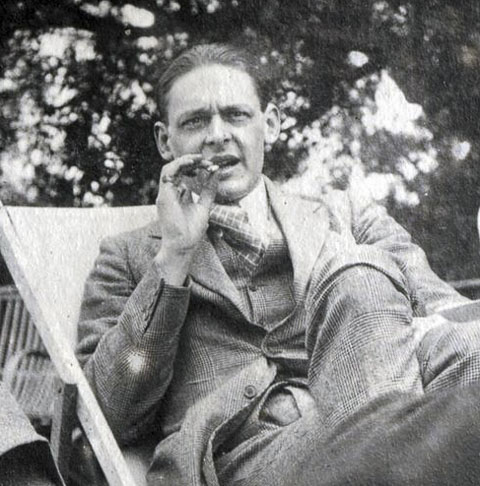 T. S. Eliot in 1923
T. S. Eliot in 1923
Equally worth noting, however, once he was established as a major literary figure with a comfortable income, Eliot made trips back to the United States. After a visit in the late autumn of 1950, these trips were to become part of his routine, “a regular event” in the final decade and a half of his life. There was, as Peter Ackroyd observes in his biography of Eliot, “a sense in which he was returning home.”[2] Eliot was returning in 1950, not to his own St. Louis and Twain’s Missouri but to Boston, where he visited, along with relatives, old friends Emily Hale (who had preceded Eliot’s first wife, Vivien, as a romantic interest and hoped to succeed her) and Djuna Barnes (whose lesbian novel Nightwood Eliot had admired and shepherded, delicately edited, through Faber & Faber in 1936). Novelist and translator Willa Muir, who also saw him at this time, reported: “Tom Eliot is much more human here than in England. He was less cautious, smiling more easily, spontaneous in repartee, enjoying the teasing he was getting from Djuna,” in whose “company he seemed to have shed some English drilling and become more American.”[3]
Eliot may have “become more American,” in part, because he had just written an Introduction to Adventures of Huckleberry Finn.[4] Perhaps like “most of us,” Eliot suggests early in that Introduction, Mark Twain “never became in all respects mature. We might even say that the adult side of him was boyish, and that only the boy in him, that was Huck Finn, was adult” (322). In the transformed Eliot Willa Muir described in 1950, we may have not only a man loosened up by the liberated Barnes, but, as Ackroyd suggests, filled with memories of his own childhood, “still to be wished for although lost and gone forever” (301-2).
Willa Muir’s observation of the American humanizing of Anglican and priggish Eliot in 1950, her refreshing account of his spontaneity and boyish enjoyment, may indeed remind us of the Huck he had recently been writing about. That relaxed pleasure might also remind us, if we have been rummaging among his unpublished papers in Yale’s Beinecke Library, that Eliot confided to Ezra Pound in 1961 that there had been only two happy periods in his life. The last was during his second marriage, to Valerie. The first, he said, was “during his childhood”: a lost boyhood that may have been glimpsed, in part through the prism of Huck, by the adult and successful Thomas Stearns Eliot (in 1950 almost as world-famous as Mark Twain himself had been), returning to America to lecture and see his sisters.
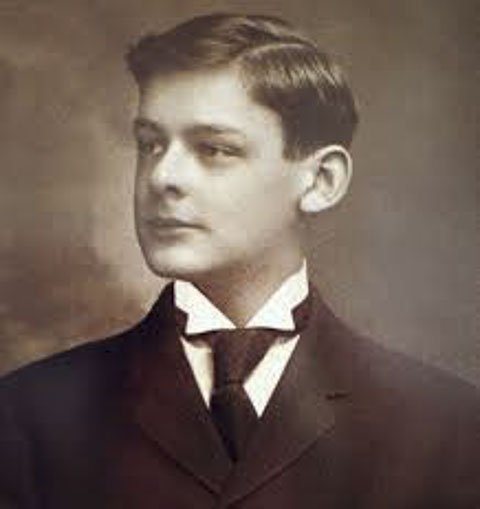 Young Tom Eliot
Young Tom Eliot
Huck’s impact would have been all the more powerful since, as Eliot tells us in the second paragraph of his Introduction, the novel, deemed “unsuitable” by his strict parents, was kept from him as a boy. Thus it was “only a few years” prior to writing the Introduction that “I read for the first time, and in that order, Tom Sawyer and Huckleberry Finn” (321). Eliot perceptively saw Mark Twain as a “composite” of Tom, applause-seeking, and Huck, “indifferent” to fame and conventional success; and he may have had in mind his own situation as a famous public figure in describing Mark Twain as a man who sought success, approval, and reputation, yet simultaneously “resented their violation of his integrity” (322).
But there are two interrelated problems with this 1950 connection between Huck and Eliot’s inner boy. The first is that the one phrase Ackroyd quotes from Eliot’s Introduction (the impossibility of either Huck or the river having “a beginning or end”) may remind us of Eliot’s defense of the much-disputed ending of the novel. Eliot insists that “all great works of art,” among which he numbers Huckleberry Finn, “mean much more than the author could have been aware of meaning….So what seems to be the rightness, of reverting at the end of the book to the mood of Tom Sawyer, was perhaps unconscious art” (326-27).
One can agree with Eliot that for Huck “neither a tragic nor a happy ending would be suitable” (327), and that no “book ever written ends more certainly with the right words: ‘But I reckon I got to light out for the territory ahead of the rest, because Aunt Sally she’s going to adopt me and sivilize me, and I can’t stand it. I been there before’.” But one resists his repeated insistence on the “rightness” of the novel’s reversion, in the so-called “evasion” chapters, to the mood of Tom Sawyer.
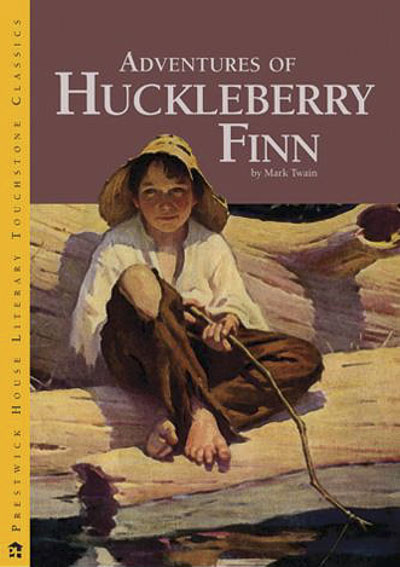
.
2.
Eliot’s final formulation—“it is right that the mood at the end of the book should bring us back to that of the beginning” (326)—seems more appropriate to Eliot, as poet and as man, or to Mark Twain himself, who famously came into the world, and left it, with Halley’s Comet lighting up the sky, than to the conclusion of Twain’s novel. Eliot’s Four Quartets enacts that rondure; and his own ashes rest in the Parish Church of St. Michael’s, East Coker, in Somerset, the place of origin from which, centuries earlier, his ancestors had emigrated to America. Eliot had his memorial tablet circumscribed by the opening and closing lines from “East Coker” (1940), the second of Four Quartets: “In my beginning is my end….in my end is my beginning.” But to apply, as Eliot does, a similar circuitous journey to the Adventures of Huckleberry Finn is to rationalize the flaw in Mark Twain’s masterpiece and to endorse, in Huck’s case, a regression that betrays the boy’s instinctive and gradually more articulate commitment to freedom. For most readers, freedom is the principal theme of the book, even if it takes the limited form of “sliding down the river” on the raft, “free and easy”—Huck’s and Jim’s joyous freedom in harmony with nature, in contrast to corrupt civilization: the societal violence, malice, and vulgarity exhibited in the towns along the shore.
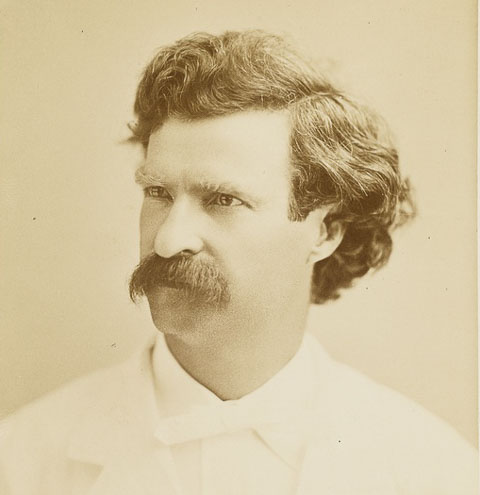 Mark Twain in 1882, two years before publication of Adventures of Huckleberry Finn
Mark Twain in 1882, two years before publication of Adventures of Huckleberry Finn
The second, and intimately related, problem is that Eliot, who here privileges rondure above almost all else, seems less interested in “freedom”—embodied in, and symbolized by, Huck and, of course, Jim’s ultimate goal (Eliot does mention, as an illustration of the voyage-controlling power of the River, that “it will not let them land at Cairo, where Jim could have reached freedom” [325])—than in literary form, the supposed coming-full-circle structure of the novel. Though, as a non-specialist, I am unfamiliar with details, I am generally aware that—beginning with James M. Cox as early as 1966, followed by two close readings in 1991, by Victor A. Doyno and Richard Hill—there have been many sophisticated post-Eliot defenses of the sustained ending of Huckleberry Finn.[5] “But”—to quote Huck himself rejecting (at the end of Chapter 3) the early fooleries of Tom Sawyer (as I wish he had rejected his later Gothic grotesqueries at Jim’s expense at the Phelps Farm)—“as for me I think different.”
I’m hardly alone. As early as 1932, in Mark Twain’s America, Bernard DeVoto, the scholar-critic whose professionalism made accessible Twain’s scattered papers, said of the ending of Huckleberry Finn: “In the whole reach of the English novel there is no more abrupt or more chilling descent.”[6] The landmark attack on the ending came in 1953, in the wake of the publication of both Eliot’s and Lionel Trilling’s introductions to popular editions of Huckleberry Finn. In an eloquent and immensely influential essay, Leo Marx took issue with both these major critics and men of letters, arguing persuasively that, while “both critics see the problem as one of form,” it is the content, “the discordant farcical tone and the disintegration of the major characters,” that “makes so many readers uneasy because they rightly sense that it jeopardizes the significance of the entire novel.”
This is no minor matter since, as Marx forces us to remember, the ending “comprises almost one-fifth of the text.” For Marx (as for much of the book’s audience, if not for its author, whose experience of slavery made him more realistic about racial matters), the novel has “little or no formal unity independent of the joint purpose of Huck and Jim.” Those yearning for a more affirmative conclusion to Huck’s and Jim’s “joint purpose” are bound to find the ending—in which Huck is again subservient to Tom Sawyer and Jim is reduced, as a result of Tom’s antics, to a caricature of a slave—particularly egregious. The formalist stress of both Trilling and Eliot, in particular their defense of the ending, comes at a considerable human and ultimately aesthetic cost.[7] We register the pressure of historical realism, but, for Marx and many others, myself included, the movement of the novel, however episodic, into a serious moral world is betrayed by the return at the end to buffoonery and cruel slapstick at Jim’s uncomplaining expense.
Eliot should have known better. In his Introduction, singling out as the best illustration of the relationship between Huck and Jim, he chose the conclusion of the chapter (15) in which, after the two have become separated in the fog, Huck in the canoe and Jim on the raft, Huck, “in his impulse of boyish mischief,” persuades Jim for a time that he had dreamt the whole episode. Heartbroken at the “loss” of Huck, and weeping “thankful” tears to see him back again, Jim realizes what has actually happened, the trick Huck has played: “En all you wuz thinkin‘ ’bout wuz how you could make a fool uv ole Jim wid a lie. Dat truck dah is trash; and trash is what people is dat puts dirt on de head er de fren’s en makes ’em ashamed.” It was “fifteen minutes,” Huck tells us, “before I could work myself up to go and humble myself to a nigger—but I done it, and I warn’t ever sorry for it afterwards neither.”
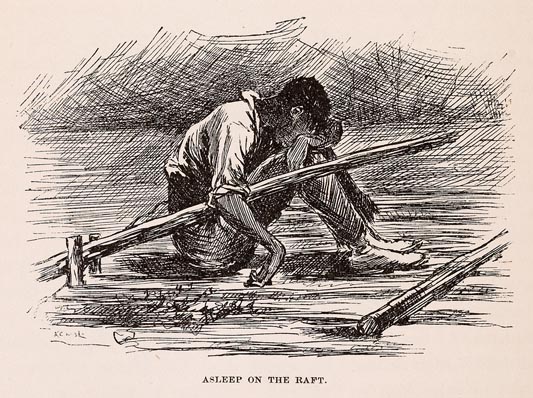 Illustration by Edward W. Kemble from first ed., via University of Virginia
Illustration by Edward W. Kemble from first ed., via University of Virginia
Aware that the passage had been often quoted, Eliot quotes it again, not only because of the obvious “pathos and dignity of Jim,” which is “moving enough,” but because of something often “overlooked” and even more profound: the “pathos and dignity of the boy, when reminded so humbly and humiliatingly, that his position in the world is not that of other boys, entitled from time to time to a practical joke; but that he must bear, and bear alone, the responsibility of a man” (324). Given that insight, it is all the more painful that Eliot should so glibly accept Huck’s resubmission to Tom Sawyer’s leadership and to the protracted “practical joke” at Jim’s expense in the final chapters, even celebrating those chapters’ “rightness”—all under the aegis of rondure: a reversion at the end to the novel’s beginning, even to the “mood” of Tom Sawyer rather than of Huck’s own book.
To embrace as “right,” even “inevitable,” the “Evasion” chapters violates the integrity of Huck’s own maturing character, from his instinctive alliance with Jim (“They’re after us”) to his momentous, “awful,” decision, in Chapter 31, to defy the law and contemporary “morality” rather than betray Jim. Having just written a note to Miss Watson, revealing Jim’s capture, Huck, as we all remember, holds the letter in his hand: “I was a trembling, because I’d got to decide, forever, betwixt two things, and I knowed it. I studied a minute, sort of holding my breath, and then says to myself, ‘All right, then, I’ll go to hell’—and tore it up.”
Whether or not he recalled that Huck had earlier chosen to go to the “bad” rather than the “good” place, providing Tom Sawyer was there, Eliot says not a word about this crucial decision. That seems remarkable since, as epitomized by his reading of the fog episode, Eliot is attuned to the “kinship of mind and the sympathy between the boy outcast and the negro fugitive from the injustice of society.” He even remarks, finely, that Huck would be “incomplete without Jim, who is almost as notable a creation as Huck himself,” and that “they are equal in dignity” (323-24). Earlier, in the context of praising Twain’s pivotal decision to write “in the person of Huck,” Eliot adds that “the style of the book, which is the style of Huck, is what makes it a far more convincing indictment of slavery than the sensationalistic propaganda of Uncle Tom’s Cabin” (322-23). But just as he forgets that, unlike Twain’s, Stowe’s novel was written when slavery was still an issue,[8] Eliot is silent about Huck’s defiant willingness to “go to hell” rather than turn Jim in as a runaway slave. One can imagine the conservatively religious Eliot resisting that last assertion as hyperbole, sympathetic or blasphemous, even saying, in a favorite and recurrent formulation of Huck’s (repeated in Chapters 3, 15, and 34): that was one “too many for me.”
.
3.
Eliot was of course impressed by Huck’s demotic but rhapsodic descriptions of the Mississippi, its majesty and movement. Eliot stresses its power and thematic unifying force: “It is the River that controls the voyage of Huck and Jim,” the River that “separates…and re-unites them….Recurrently, we are reminded of its presence and its power” (325). Eliot had personal experience of the power of the Mississippi. In evoking that power in his Introduction, Eliot refers to “the great Eads Bridge,” the river-spanning steel structure which, unlike earlier bridges, “could resist the floods” (325). Two decades earlier, Eliot had told an interviewer that, as a boy, “the big river” made a “deep impression on me; and it was a great treat to be taken down to the Eads Bridge”—at the time of its 1874 opening the largest ever built—“in flood time.” It is a useful reminder of Hugh Kenner’s emphasis on Eliot’s “birthplace by Twain’s Mississippi in Twain’s lifetime.”
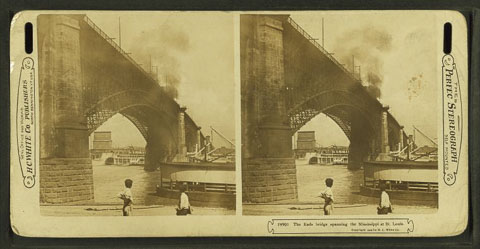 Eads Bridge, St. Louis, Missouri, between 1873-1909, courtesy New York Public Library Digital Collection
Eads Bridge, St. Louis, Missouri, between 1873-1909, courtesy New York Public Library Digital Collection
In a much later interview, referring to the “sources” of his poetry, Eliot said that, “in its emotional springs, it comes from America.” He was referring less to American literature than to American locale, landscape, and language.[9] In 1953, Eliot noted that in Huckleberry Finn, Mark Twain
reveals himself to be one of those writers, of whom there are not a great many in any literature, who have discovered a new way of writing, not only for themselves but for others. I should place him in this respect, even with Dryden and Swift, as one of those rare writers who have brought their language up to date, and in so doing, “purified the dialect of the tribe.”[10]
These linguistic observations had been anticipated in the Huckleberry Finn Introduction. “Repeated readings of the book,” says Eliot, “only confirm and deepen one’s admiration of the consistency and perfect adaptation of the writing. This is a style which at the period, whether in America or in England, was an innovation, a new discovery in the English language.” Other novelists had achieved “natural speech” in relation to particular characters, “but no one else had kept it up through the whole of a book,” and flawlessly: “there is no sentence or phrase to destroy the illusion that these are Huck’s own words” (323).
 Twain with his family around the time Adventures of Huckleberry Finn was published
Twain with his family around the time Adventures of Huckleberry Finn was published
That last point is, Huck himself might say, a bit of a “stretcher.” Though the history is wonderfully recast in his own terms, the unschooled Huck knows more than seems plausible about British and French royalty, not to mention Hamlet’s soliloquy, as rendered by the rapscallion “Duke.” It might be added that, in terms of Eliot’s own poetry, despite his linguistic insights here, while he may have purified the dialect of the tribe, he seldom varied from his increasingly British-inflected diction; and even there he could not catch the working-class vernacular required for the pub-scene of The Waste Land without the help of his wife, Vivien, her ear attuned to “lower-class” speech. Eliot never approached the vernacular innovation of Mark Twain in Huckleberry Finn. A semblance of that achievement was reserved to William Carlos Williams who, while admiring the brilliance of The Waste Land, deplored and feared its impact. In his Autobiography (1951), written three decades after he registered the shock of The Waste Land, Williams described Eliot’s poem as a “great catastrophe” that “returned us to the classroom just at the moment when I felt we were at the point of escape to…the essence of a new art form” (164). Though it took years to come out from the shadow of the Eliotic rock, eventually Williams emerged as the pioneer who, fulfilling Whitman and perhaps Twain, achieved a distinctively American poetry employing colloquial speech, and so became, for future generations of American poets, more influential than Eliot.
To return to Twain’s masterpiece: Eliot had asserted from the outset that in “the writing of Huckleberry Finn Mark Twain had two elements which, when treated with his sensibility and his experience, formed a great book: these two are the Boy and the River” (320). The Boy “is the spirit of the River,” and we “come to understand the River by seeing it through the eyes of the Boy” (325), whose human voice is as much a unifying element as the River. Considerations of style and speech shift attention from the river itself to the life on the raft the river makes possible for that boy and for Jim; and to the language, the dialect, Twain invents for Huck to express his love of the river. The vital center of the novel, early in Chapter 19, precedes the intrusive arrival of the “King” and the “Duke.” The days and nights, Huck tells us, “slid along so quiet and smooth and lovely….you see the mist curl up off the water and the east reddens up, and the river,” and then from across the river, “the nice breeze springs up and comes fanning you, so cool and fresh and sweet to smell, on account of the woods and the flowers,” though “sometimes” there is also the rank smell of dead fish; “and next you’ve got the full day and everything smiling in the sun, and the songbirds just going it!”
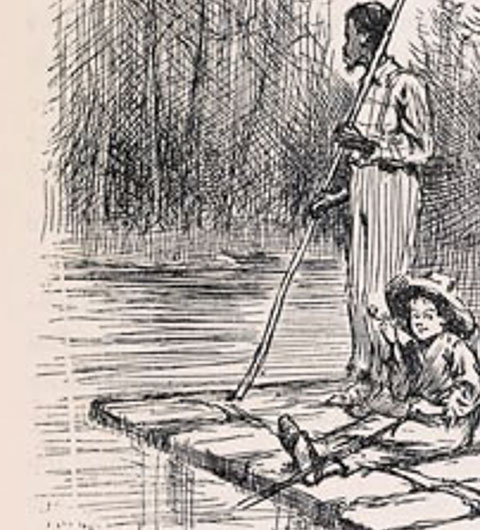 Illustration by Edward W. Kemble from first ed., via University of Virginia
Illustration by Edward W. Kemble from first ed., via University of Virginia
Two paragraphs later, our attention is turned to the night sky and to some seemingly casual but in fact rather significant cosmological/theological speculation: “It’s lovely to live on a raft. We had the sky up there, all speckled with stars, and we used to lay on our backs and look up at them, and discuss about whether they was made, or only just happened—Jim he allowed they was made, but I allowed they happened; I judged it would have took too long to make so many.” Though far more cheerful than the author of The Mysterious Stranger or Twain’s other late, dark fables, Huck seems as much a skeptic or agnostic as Mark Twain. And he is a loner. His companionship with Jim, however warm, is temporary, ultimately unsustainable. Huck is, as Eliot notes, “alone: there is no more solitary character in fiction” (322). And, as suggested by this passage, stressing chance rather than divine design, Huck—while he believes in providence, heaven and hell—has no god, riverine or celestial. He has, instead, his alert senses and native intelligence, even something of Coleridge’s “shaping spirit of imagination,” made flesh in the incomparable language given to him by Mark Twain.
.
4.
To re-focus on the second of Eliot’s two elements: If it is “Huck who gives the book style,” it is “the River” that gives it “form,” and makes it a “great book.” Eliot contrasts Twain’s Mississippi to the Congo of Conrad, who, in Heart of Darkness, constantly reminds us of “the power and terror of Nature, and the isolation and feebleness of Man.” But unlike Conrad, who remains always “the European observer of the tropics, the white man’s eye contemplating the Congo and its black gods,” Mark Twain “is a native, and the River God is his God. It is as a native that he accepts the River God, and it is the subjection of Man that gives to Man his dignity. For without some kind of God, Man is not even very interesting”
At this point (325-26), agnostic Huck and agnostic Twain have been pushed offstage to make way for theistic T. S. Eliot, a committed Christian believer, who has, nevertheless, more than a few things to say about animistic River Gods. “The Dry Salvages” (1941) famously begins: “I do not know much about gods; but I think that the river/ Is a strong brown god…” This poem, the third of Four Quartets, is set on the New England Coast, but its opening movement summons up, along with “The River” section of Hart Crane’s The Bridge, Twain’s river, which becomes, as Eliot notes in his Introduction to the novel, “the Mississippi of this book only after its union with the Big Muddy—the Missouri” (327). The specifically “Southern” muddiness of the river in “The Dry Salvages” becomes uncomfortably clear in lines 117-18: “Time the destroyer is time the preserver,/ Like the river with its cargo of dead negroes, cows and chicken coops.” “Cargo” casually evokes the commercial heritage of slavery, the antebellum world of the Adventures of Huckleberry Finn; and, like the more notorious “spawned” and squatting “jew” in “Gerontian” (elevated, more than forty years later, in 1963, to the uppercase), the dead “negroes,” tossed in with cows and chicken coops, are, if it is not too politically correct to note, subordinated to lowercase status.
This is hardly the place to relitigate Eliot’s anti-Semitism; but we may legitimately wonder if, despite his expressed admiration for Jim as Huck’s equal in “dignity,” the apparent indifference to Jim’s plight implicit in Eliot’s endorsement of Twain’s final chapters has something to do with vestigial racism. We were alerted to Eliot’s early attitude with the publication, in 1997, of notebook poems written when he was in his twenties, especially the scatological and racist doggeral starring “Bolo,” a sexually well-endowed Negro monarch, attended by a “set of blacks,” a “hardy” and “playful lot/ But most disgusting dirty,” and the poem featuring an imaginary interview with Booker T. Washington alternately titled “Up From Possum Stew!” or “How I Set the Niggers Free!”[11] It is unfair to saddle the mature poet and critic with ribald juvenilia never intended to be published; and, as we have seen, there is nothing offensive or racially insensitive, quite the opposite, in what Eliot has to say of Jim in the Introduction to Huckleberry Finn. But readers hostile to Eliot might wonder if it is possible that, in making the case he does for the final Jim-imprisoning chapters of Twain’s novel, Eliot was, as late as 1950, still less than passionately interested in setting Niggers free.
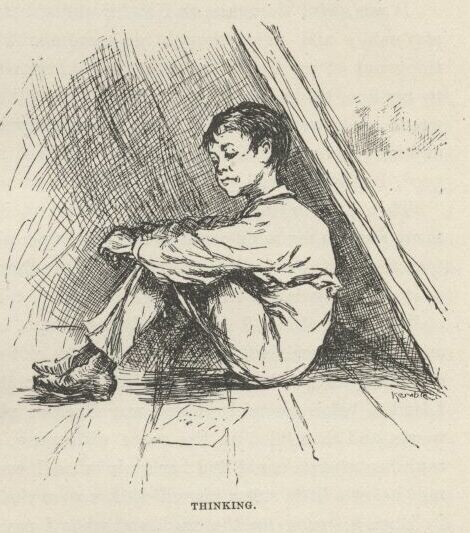 Illustration by Edward W. Kemble from first ed., via University of Virginia
Illustration by Edward W. Kemble from first ed., via University of Virginia
To return, with relief, to the River: it is always capitalized by Eliot, who personifies and deifies the powerful, all-controlling Mississippi. Like Huck, “the River itself has no beginning or end. In its beginning, it is not yet the River; in its end, it is no longer the River.” Having flowed from many headwaters, it “merely disappears among its deltas.” But, since the people who “live along its shores or who commit themselves to its current” are all subject to its flow, “the River gives the book its form. But for the River, the book might be only a sequence of adventures with a happy ending” (327). In the finale, Jim is revealed as free, Pap as dead, and Huck has $6,000 to fund his next adventure, in the Indian Territory. But Eliot had earlier said that it would be “unsuitable” for Huck to have either “a tragic or a happy ending.” And in the worst reading of the latter, Eliot may have decided that the novel’s Evasion chapters, taken as a whole, not only illustrate rondural “rightness,” but constitute a “happy ending.” If so, he would seem to have adopted the attitude of Tom Sawyer, who thought keeping Jim locked up the “best fun he ever had in his life,” and hoped to delay his escape indefinitely (Chapter 36).
.
5.
Since Huck, like the River, “has no beginning and no end,” he, too, can “only disappear.” And, Eliot adds, crucially and dubiously, “his disappearance can only be accomplished by bringing forward another performer to obscure the disappearance in a cloud of whimsicalities” (327). But the more-than-whimsical torments inflicted on Jim by Tom, following the “rules” of Romantic escape-literature, include snakes, spiders, and rats, a menagerie that kept the terrified prisoner awake since “they never slept at one time, but took turn about” (Chapter 39). In all of this, though he occasionally offers practical suggestions to counter the more absurd of his friend’s literary fantasies, Huck defers to Tom’s authority.
The only time he is seriously critical comes at the very beginning, when Tom, yet to work out what will become his ever-more-elaborate “escape” plan, agrees to help save Jim. Huck merely wants him “to keep mum and not let on,” but “Tom’s eye lit up, and he says: I’ll help you steal him!” An outlaw at peace with his own decision, Huck is shocked to discover that Tom, a mischief-maker but a “respectable” member of the law-abiding community, is more than willing to help Jim escape. “It was,” says Huck, “the most astonishing speech I ever heard—and I’m bound to say Tom Sawyer fell, considerable, in my estimation. Only I couldn’t believe it. Tom Sawyer a nigger stealer!” (Chapter 33). Only when Tom belatedly reveals that Jim has already been freed in Miss Watson’s will does he regain full respectability in Huck’s eyes!
If, despite his development in the course of the novel, Huck is still of the South, so, and even more obviously, is Tom. Whatever we make of Tom’s behavior, we join Huck in admiring his friend’s fertile imagination as well as his “pluck.” The gunshot leg-wound he received during the escape, welcomed by Tom as a badge of honor, might have proved fatal if not for Jim’s help. And yet an inescapable premise of the prolonged ordeal to which Tom subjected Jim is that its victim was somehow subhuman. The real villain is not Tom, but the society that produced him. “All Europe,” Conrad tells us in Heart of Darkness, “contributed to the making of Kurtz”; so all of the American South—though unnoticed by Conrad-admirer and Missourian T. S. Eliot—contributed to the making of the racially-unenlightened if far more appealing Tom Sawyer. Nor is Huck untainted. [12]
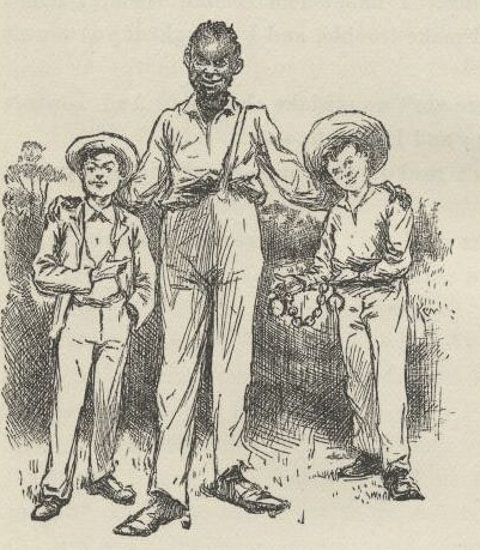 Tom, Jim, and Huck — Illustration by Edward W. Kemble from first ed., via University of Virginia
Tom, Jim, and Huck — Illustration by Edward W. Kemble from first ed., via University of Virginia
This recalcitrance of history is often lost in our tendency—not unlike the American love affair with the film Casablanca—to lavish affection on a book which for many, especially in the wake of Ernest Hemingway’s encomium in the mid-1930s, is the “great American novel.” Placing Huckleberry Finn in the context of longstanding American cultural debates, historicist critic Jonathan Arac registered the virtues of the novel while also pronouncing it mean-spirited. Writing in 1997, he warned against that overloading of the book with cultural value that had led to feel-good white liberal complacency regarding race. And what he called the “hypercanonization” and “idolatry” of Huckleberry Finn was a flaw-forgiving development contributed to, Arac claimed, by Eliot’s Introduction to the novel.
Four years later, Ann Ryan examined Arac’s view that the now iconic Huckleberry Finn has an undeserved reputation as a novel that somehow resolved the issue of racism. In Ryan’s concise synopsis of Arac’s argument, critics since the 1940s, “self-consciously engaged” in an interpretive process, “equated Huck with tolerance and love, Twain with Huck, and America with Twain.” Reacting to the “self-serving criticism” of the “white literary establishment,” Arac represents Huckleberry Finn, not as healing or resolving, but “as a novel with a mean spirit and Twain as an author with a hard heart.” Countering Arac, Ryan argues that “it is precisely this raw quality, in both the book and its author,” that makes Huckleberry Finn a valuable asset in contemporary discussions of race, in general and in the classroom. She argues persuasively that, while Twain “evades political entanglements,” he “intentionally represents this evasion”; and that while the novel clearly “operates on racist assumptions and privileges,” it “unflinchingly illustrates how both are expressed and defended.”
Finally, there is the matter, troubling to so many critics, of Twain’s sense of humor and penchant for practical jokes. Registering Huck’s empathy even for rascals, Ryan reminds us that, sickened by the final tar-and-feathered plight of the King and Duke, Huck concludes, “It was a dreadful thing to see. Human beings can be awful cruel sometimes” (Chapter 33). Ryan then notes the final ironic twist: that “Twain ends his novel with a grotesque practical joke at the expense of Jim, the most ‘human’ being in the narrative.” Regarding Twain’s employment of humor as a possible “imaginative response to our racist history,” Ryan concludes: “If Twain imagines that race is a joke, he does not necessarily mean that we should not take it seriously.”[13]
We can appreciate this multilayered irony. And, whether “serious” as opposed to common readers like it or not, there are genuinely funny moments in the final chapters; Twain himself certainly enjoyed trotting out Tom’s shenanigans in his stage performances, and drew the laughter he always sought. Still, it hurts to see Huck subordinate himself to Tom, whose extravagant, ever-proliferating machinations simply go on too long (as virtually every critic, even Eliot and Lionel Trilling acknowledged), sometimes becoming as tedious as they are otiose and cruel. If Jim, reduced to a minstrel character, even emasculated, rigged out in Aunt Sally’s calico dress, doesn’t mind, we do, or should, especially since Tom withholds, even from Huck, the fact that Jim has already been legally freed.
Mark Twain may have been “cheating” at the end, as Hemingway famously charged in nevertheless celebrating the novel as “the source of all modern American literature.”[14] Or Twain may have reverted to his customary cap and bells simply because he remained confused, troubled as he had been from the beginning of his work on the book in 1876, as to how to bring the journey of Jim and Huck to a successful conclusion. Or he may just not have been able to resist a practical joke, even one as strung out and seemingly anticlimactic as Tom’s Great Escape, especially not if, as Ann Ryan suggests, it constitutes a racial joke that Twain “does not necessarily mean we should not take seriously.”
One can understand how, psychologically, back in the shore-world and under the sway of a self-confident leader like Tom Sawyer, an adolescent boy, even one as experienced and practical-minded as Huck, might regress, and the mores of Southern society reassert themselves. But, all joking aside, realism needn’t require farce, sporadically funny but finally dehumanizing. Eliot insists that the chapters detailing Tom’s protracted buffoonery at Jim’s expense (with the painful complicity of Huck, who hasn’t a malicious bone in his body) have the “rightness” of “art,” whether conscious or “unconscious.” I remain unpersuaded.
Like the issue of racism itself, the debate over the final section of Huckleberry Finn—a debate as protracted as Tom’s evolving escape plans—may be ultimately irresolvable. But those on my side of that debate can only regret that T. S. Eliot—given his immense authority circa 1950, as world-famous poet-critic and Nobel laureate—should have put his imprimatur on what seems to us an error. As Eliot had announced in 1928, re-invented, now more English than American, he was not only royalist in politics and Anglo-Catholic in religion; he was a “classicist in literature,” and so, though a modernist poet, still wedded to what he called (in the subtitle of the book in which he made that triple announcement) “style and order.” In the case of the Adventures of Huckleberry Finn, in mounting so eloquent a rondural defense, evoking the venerable symbol of the ouroboros, Eliot in effect validated Mark Twain’s original sin against his own (or Huck’s) book—a book which is not only, as Eliot himself asserted by emphasizing the unifying power of the River, a series of picaresque adventures, but something of a bildungsroman. In defending what many readers continue to find indefensible, the formalist Eliot himself paid too high a critical price in order to have Mark Twain’s novel, to quote one of Eliot’s favorite poets, “end where it begunne.”[15]
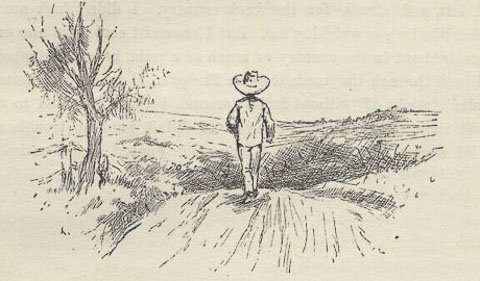 Illustration by Edward W. Kemble from first ed., via University of Virginia
Illustration by Edward W. Kemble from first ed., via University of Virginia
—Patrick J. Keane
Works Cited
Ackroyd, Peter. T. S. Eliot: A Life. New York: Simon and Schuster, 1984.
American Literature and the American Language. Washington U Studies, New Series Language and Literature, No. 22. St. Louis, 1953.
Arac, Jonathan. Huckleberry Finn as Idol and Target: The Functions of Criticism in Our Time. Madison: U of Wisconsin Press, 1997.
Cox, James M. Mark Twain: The Fate of Humor (1966); excerpt as reprinted in Graff and Phelan, 305-12.
DeVoto, Bernard. Mark Twain’s America. Boston: Little, Brown, 1932.
Doyno, Victor A. Writing “Huck Finn”: Mark Twain’s Creative Process. Philadelphia: U of Pennsylvania Press, 1991.
Eliot, T. S. For Lancelot Andrewes: Essays on Style and Order. London: Faber & Faber, 1928.
________. Four Quartets, in T. S. Eliot: The Complete Poems and Plays. New York: Harcourt, Brace & World, 1952.
________. Inventions of the March Hare, ed. Christopher Ricks. London: Faber, 1997.
________. Introduction to Huckleberry Finn (1950), in Twain, 320-27.
_______. The Letters of T. S. Eliot, ed. Valerie Eliot and John Haffenden, 7 vols. to date. London: Faber & Faber, 2008-2017.
Epstein, Joseph. Narcissus Leaves the Pool. Boston: Houghton Mifflin Harcourt, 1999.
Graff, Gerald, and James Phelan, Eds. Adventures of Huckleberry Finn: A Case Study in Critical Controversy. Boston and New York: Bedford Books of St. Martin’s Press, 1995.
Hemingway, Ernest. Green Hills of Africa. New York: Scribner, 1935.
Hill, Richard. “Overreaching: Critical Agenda and the Ending of Adventures of Huckleberry Finn.” Texas Studies in Literature and Language (Winter 1991); cited as reprinted in Graff and Phelan, 312-34.
Kenner, Hugh. The Pound Era. Berkeley and Los Angeles: U of California Press, 1971.
Marx, Leo. “Mr. Eliot, Mr. Trilling, and Huckleberry Finn.” The American Scholar 22 (1953), 423-40; cited as reprinted in Twain, 328-41.
Moody, David A., ed. The Cambridge Companion to T. S. Eliot. Cambridge: Cambridge U Press, 1994.
Plimpton, George, ed. Writers at Work. New York: Penguin, 1977, 2nd series.
Ryan, Ann. “Black Genes and White Lies: The Romance of Race,” in Trombley and Kiskis, 167-91.
Sigg, Eric. “Eliot as a Product of America,” in Moody, 14-30.
Trombley, Laura E. Skandera, and Michael J. Kiskis, ed. Constructing Mark Twain: New Directions in Scholarship. Columbia and London: U of Missouri Press, 2001.
Twain, Mark. Adventures of Huckleberry Finn. The Norton Critical Edition, ed. Sculley Bradley, Richmond Croom Beatty, and E. Hudson Long. New York: Norton, 1962.
Williams, W. C. The Autobiography of William Carlos Williams. New York: New Directions, 1951.
x
x
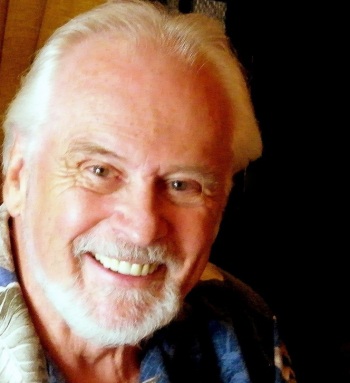
x
Numéro Cinq Contributing Editor Patrick J. Keane is Professor Emeritus of Le Moyne College. Though he has written on a wide range of topics, his areas of special interest have been 19th and 20th-century poetry in the Romantic tradition; Irish literature and history; the interactions of literature with philosophic, religious, and political thinking; the impact of Nietzsche on certain 20th century writers; and, most recently, Transatlantic studies, exploring the influence of German Idealist philosophy and British Romanticism on American writers. His books include William Butler Yeats: Contemporary Studies in Literature (1973), A Wild Civility: Interactions in the Poetry and Thought of Robert Graves (1980), Yeats’s Interactions with Tradition (1987), Terrible Beauty: Yeats, Joyce, Ireland and the Myth of the Devouring Female (1988), Coleridge’s Submerged Politics(1994), Emerson, Romanticism, and Intuitive Reason: The Transatlantic “Light of All Our Day” (2003), and Emily Dickinson’s Approving God: Divine Design and the Problem of Suffering (2008).
x
x
- On Eliot’s wearing of the white rose, see Joseph Epstein, “Anglophilia, American Style,” in his Narcissus Leaves the Pool, 241. For Frost’s comment, see The Letters of T. S. Eliot, 4:286, n.1. Eliot’s own famous pronouncement about his stance in literature, politics, and religion—a cause of much consternation among modernist literati—occurs in the Preface to his For Lancelot Andrewes: Essays on Style and Order.↵
- Kenner, The Pound Era, 274-75. Ackroyd, T. S. Eliot: A Life, 300-01.↵
- Muir, Belonging: A Memoir (London: Hogarth Press, 1968); as quoted in Ackroyd, 301.↵
- The edition Eliot introduced was published in 1950, by The Cresset Press in London, and Chanticleer Press in New York. It is reprinted in The Norton Critical Edition of the Adventures of Huckleberry Finn. Twain, 320-27. I quote parenthetically from this edition.↵
- In Mark Twain: The Fate of Humor, Cox insists that, since Huck’s journey has never been a “quest,” but an “escape,” a flight “from tyranny, not a flight toward freedom,” his behavior in the final chapters is in character; and that, while we “become uncomfortable when he submits to Tom’s role,” Mark Twain knew what he was doing: “The entire burlesque ending is a revenge upon the moral sentiment which, though it shielded the humor, ultimately threatened Huck’s identity” (312). Two adroit defenses of the ending appeared in 1991, the first by Victor A. Doyno, whose extensive study of the manuscripts of Huckleberry Finn informs his Writing “Huck Finn”: Mark Twain’s Creative Process. In his 10th and final chapter, “Repetition, Cycles, and Structure,” Doyno defends the novel’s unity, including the ending. In arguing that, “in a complex way the ending is aesthetically and thematically appropriate,” he questions both the social and genre-assumptions of those who want a bildungsroman rather than a series of “adventures.” In establishing a strong contrary case against those critics put off by the novel’s final chapters, he notes that, however “severely criticized” it has been, the ending “does resolve several problems,” not least the issue of Jim, who is “decriminalized” (223-27). In his informed and acerbic essay on critical “overreaching” in assaults on the ending of the novel, Richard Hill attacks Leo Marx and the critics who followed his lead. Hill, too, finds Huck in character in the final chapters. “To expect Huck to give up instantly both his ongoing personality and Tom Sawyer is to push the epiphany aspect of his decision to tear up the letter to Miss Watson into the excesses of modern social-agenda fiction.” Nor, he argues, is Jim reduced to a caricature. (320, 323-27)↵
- DeVoto, Mark Twain’s America, 92.↵
- Trilling’s Introduction to the 1948 Rinehart edition was reprinted in 1950 in his The Liberal Imagination. Marx, “Mr. Eliot, Mr. Trilling, and Huckleberry Finn,” 329.↵
- What Jonathan Arac has called the “hypercanonization” of Huckleberry Finn at the specific expense of Uncle Tom’s Cabin began in the 1920s and has continued—despite praise of Stowe’s novel by Edmund Wilson (Patriotic Gore, 1962), Ellen Moer (Literary Women, 1976), and Arac himself (1997). That Twain’s novel, a “work of art” written well after the Civil War, has been judged a more powerful attack on slavery than Stowe’s novel, which appeared as a book in 1852, galvanized Arac into writing his reassessment and partial debunking of Twain’s novel. One catalyst was Eliot’s Introduction, which put the prestige of the “mid-century’s leading man of letters” and recent Nobel Prize winner on the side of Twain’s novel rather than the “propagandistic” Uncle Tom’s Cabin as the “far more convincing indictment of slavery.” This “mythicization of history,” Arac continues, “by which Huckleberry Finn gained the prestige of abolitionism despite its having been written at a time when slavery did not exist and was defended by no one, helped provoke me to this book.” Huckleberry Finn as Idol and Target: The Functions of Criticism in Our Time, 92-93.↵
- Both interviews mentioned in these paragraphs are cited by Eric Sigg, “Eliot as a Product of America,” in Moody, ed., 24, 28. In the first, Eliot is quoted by M. W. Childs, “From a Distinguished Former St. Louisan,” St. Louis Post-Dispatch (15 October 1930), 3B. For the second, see Writers at Work, ed. George Plimpton, 110.↵
- American Literature and the American Language, 16-17. Stéphane Mallarmé’s imperative “to purify the dialect of the tribe” occurs frequently in Eliot, most notably in the nocturnal encounter with the “familiar compound ghost” (mostly Yeats) in Part II of “Little Gidding,” the finest section of the last and best of Four Quartets.↵
- Eliot, Inventions of the March Hare, edited with scholarly thoroughness and annotated, copiously, brilliantly, and protectively, by Christopher Ricks.↵
- We recall the opening exchange (Chapter 32) between Aunt Sally and Huck (pretending to be Tom, and to have experienced an accident on the boat): “Good gracious! Anybody hurt?” “No’m. Killed a nigger.” “Well, it’s lucky,” replies this affectionate woman; “because sometimes people do get hurt.” Though admirers of Huck would rather repress the memory, there is that two-chapter stretch between the running over the raft by a steamboat, with the apparent loss of Jim (toward the end of Chapter 16), and the moment, in Chapter 18, when he is rediscovered by Huck (less emotionally than we would expect, even though Jim weeps with joy). In the interim, Huck, engaged in onshore adventures, has had not one thought of a friend he doesn’t know is dead or alive. This is troubling, whether we attribute the thoughtlessness to a Southern-inflected flaw in Huck’s character; or to Mark Twain, guilty of episodic and careless plotting or to a short memory regarding offstage characters.↵
- Ryan, “Black Genes and White Lies: Twain and the Romance of Race,” 169, 170. For Arac, see n.8, above.↵
- Hemingway’s hyperbolic but endlessly repeated praise/ criticism of Huckleberry Finn occurs in that half-memoir, half-fictional account of a safari, Green Hills of Africa, 22. H. L Mencken was no less effusive in his celebration of Huckleberry Finn (a book he read annually) as “Himalayan,” a masterpiece that soared in solitary splendor above all other American novels.↵
- John Donne’s “A Valediction: Forbidding Mourning” concludes with his brilliant compass-image—lines addressed to his wife, who remained at home while he was compelled to roam abroad: “Thy firmnes makes my circle just,/ And makes me end, where I begunne.”↵